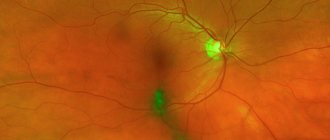Sometimes a person, looking into the distance, feels as if there is a haze before his eyes. The image loses clarity and sometimes the patient experiences dizziness. Ophthalmologists know about this phenomenon, however, they do not call it professionally, but only say that the patient has fog in his eyes.
Blurred vision can affect only one eye (be unilateral) or affect both organs (be bilateral). The veil does not have to be continuous; fog can be visualized in separate areas of the visual field. Any manifestation of the phenomenon under consideration is not identified as a separate pathology, but acts as an accompanying symptom.
Causes
Symptoms
Diagnostics
Treatment
Causes
The following factors lead to the development of the pathological process:
- clouding of the cornea caused by inflammation, trauma, burns, dystrophy;
- clouding of the lens (most often observed in patients over 60 years of age);
- pathology of the retina of the eye;
- ailments affecting the optic nerve (blurred vision is followed by pain in the eye when moving);
- refractive errors (the most common cause of blurred vision);
- the use of eye drops (the phenomenon is short-term);
- computer vision syndrome (fog occurs due to muscle spasm).
Inflammatory eye diseases such as keratitis, conjunctivitis, and iridocyclitis can lead to a veil in one eye.
Multiple sclerosis
Signals from your eye to your brain have a harder time traveling through a swollen or damaged optic nerve. Doctors don't know exactly what causes optic neuritis, but about half of people with the condition will develop multiple sclerosis within 15 years.
Vision problems are often the first symptom of multiple sclerosis.
Diagnostics
Fog in the eyes becomes a reason to conduct a detailed diagnosis. At the first stage, the doctor collects anamnesis, then checks the patient’s visual acuity using the Sivtsev table. After this, the specialist may prescribe a number of additional diagnostic procedures, including:
- measuring intraocular pressure using a tonometer;
- prescribing blood tests (general and biochemical);
- performing biomicroscopy;
- fundus examination;
- performing computed tomography and MRI.
The initial stage of a migraine attack
About 1/4 of people with migraines experience visual disturbances before a headache attack, which range from flickering zigzag lines, sparkles and flashes to blind spots and tunnel vision. It may also appear as if you are looking through water or cracked glass. This can last no more than an hour, and then everything goes away and vision becomes normal again.
Such vision symptoms can occur without a headache attack, as well as after it. If this happens frequently in only one eye, see your doctor.
Diseases
Among the most frequently diagnosed diseases that provoke such symptoms are:
- cataracts or swelling of the cornea. In addition to blurred vision, the patient experiences pain, complains of intolerance to bright light, and the shade of the cornea changes;
- secondary cataract. Appears upon completion of surgical intervention for an illness, indicates clouding in the lens bag;
- ailments of the optic nerve (atrophy, deformation, etc.). The clinical picture is complemented by a malfunction in the process of color perception, disturbances in visual fields;
- glaucoma. The patient has “pounding in the ears” and a severe headache;
- hemorrhage in the optic nerve;
- inflammatory processes accompanied by pain and burning in the eyes;
- myopia, farsightedness;
- pathologies of the retina (uveitis, retinopathy, etc.). The patient sees poorly, the latter has “lightning in his eyes”, there is no painful sensation;
- iridocyclitis. Fog is visible only in one of the eyes. The patient complains of photophobia, lacrimation, pain, and the color and pattern of the iris changes.
In addition to eye pathologies, other pathologies can be identified during the diagnostic process: hypertension, anemia, diabetes mellitus, sexually transmitted diseases, central nervous system lesions, brain injuries, etc.
Retina damage
The retina (which includes the macula) is the back part of the eye where light is focused, like on a movie screen. If something happens to this surface, such as swelling or a tear, the image in the retina may be distorted or lost.
Poor diet, smoking, a history of eye injury or disease, and other health problems such as high blood pressure, high cholesterol and diabetes can lead to macular edema and retinal detachment.
Treatment
After completing diagnostic procedures and making a diagnosis, the specialist proceeds to planning a therapeutic course. If we are talking about an eye disease, the further treatment process is controlled by an ophthalmologist. If a systemic pathology is diagnosed, the help of specialized specialists is required. Depending on the specific disease, the following types of therapeutic techniques are used:
- Correction of reduced vision (by wearing glasses and contact lenses).
- The use of drugs leading to the normalization of intracranial and intraocular pressure.
- Taking vitamin complexes and appropriate medications during the development of an infectious process. In such cases, eye drops are most often prescribed.
- Surgical intervention for glaucoma.
- Therapy for a systemic disease (for diabetes mellitus, insulin therapy, taking medications to normalize blood glucose levels).
The correct selection of glasses and contact lenses will help to avoid the progression of the disease, as well as:
- maintaining a daily routine (alternating periods of work and rest);
- normalization of sleep;
- rejection of bad habits;
- taking vitamin complexes;
- normalization of diet;
- use of eye protection (for example, UV glasses).
Thus, fog in the eyes acts as a concomitant symptom of third-party diseases, which may include both eye diseases and pathologies of other organ systems. The clinical picture is specific and determined by the disease that provokes the symptom. For diagnostic purposes, instrumental and laboratory research methods are applicable. Therapy for blurred vision includes the use of therapeutic methods (taking vitamins, vision correction with glasses and lenses, using medications to normalize blood pressure) and surgical operations.
Do you have diabetes?
When blood sugar levels are poorly controlled, fluid can leak into the lens of your eye and cause it to swell. This may happen before you are diagnosed or if you change your treatment, such as starting to take insulin.
When your sugar levels return to normal, the lens will also return to normal and your vision will become clearer. People with diabetes are more likely to suffer from retinopathy and other vision problems, which your eye doctor may detect at your annual exam.
Symptoms
Difficulties in communication.
People find it difficult to express their thoughts both verbally and in writing. Conversation seems stilted and it becomes very difficult to express your thoughts. Decreased performance. Most people notice a fairly dramatic decline in productivity. Occurs due to a decrease in psychomotor activity and dopamine production. This makes it difficult to think critically and complete tasks.
Making decisions. Difficulty or doubt appears in choosing something, be it clothes or food.
Disorganized thinking. In some cases, a person's thinking becomes disordered and very disorganized. Thoughts may be sporadic and the person may have difficulty staying on topic during a conversation.
Distraction. For example, if you are writing an article, you might write two sentences, then check Vk, then start listening to music, then start dancing, then start dinner and be afraid to go back to writing.
Errors. When performing certain tasks, you may notice that you make more mistakes than usual. This is especially common in technical work or knowledge work.
Forgetfulness. You might forget to show up for a meeting or event, forget when someone's birthday is, or where you put your car keys.
Low energy. You may not have enough energy to go to the gym or even do simple things around the house.
Memory problems. You may have difficulty forming new memories. You hear or see new information, but it does not “penetrate” your memory. Also, it is very difficult to remember anything.
Procrastination. Because your brain isn't working as fast as it used to, you start procrastinating on mental work. You become less productive and put off important tasks because it's simply too difficult to think clearly.
Psychomotor slowing. Completing tasks takes significantly longer. It feels like your brain speed is stuck. This is due to slower brain waves and performing tasks at a slower speed than usual.
Osteochondrosis of the cervical spine
Patients suffering from osteochondrosis of the cervical spine are faced with various manifestations of the disease. These include pain radiating to the arm and occipital region, and severe headaches. But perhaps one of the most traumatic symptoms is dizziness.
Medicine calls common dizziness in cervical osteochondrosis cochleovestibular symptoms. The main cause of dizziness is insufficient cerebral blood supply due to compression of the vertebral artery.
The vertebral artery supplies blood to the cerebellum, hypothalamus, inner ear and brain stem structures. It arises from the subclavian artery and runs in a canal formed by the transverse processes of the cervical vertebrae.
Why does dizziness develop? Initially, due to degenerative processes or injuries, the working structure of a segment of the spinal system in the cervical region is disrupted. Fractures, dislocations and subluxations of the joints in the cervical spine are possible, leading to displacement of the vertebrae and changes in the lumen of the canal formed by the openings of the vertebral processes. And the vertebral artery passes through the canal, which, due to the described disorders, experiences compression. Compression can also occur due to disc protrusion, the development of intervertebral hernia and inflammation.
Compression of the artery leads to a decrease in blood flow and, as a result, to oxygen starvation of the tissues of the brain. All of the above leads to the manifestation of symptoms of SPA (symptoms of the vertebral artery) - dizziness, severe throbbing headache (sharp, burning, especially intense in the back of the head and temples), visual disturbances (darkening in the eyes, a feeling of sand, spots in front of the eyes, sparks).
Dizziness is observed in varying degrees, from slight swaying, with a slight disturbance of cerebral circulation, to so-called drop attacks, when a person falls when turning his head sharply, while consciousness remains intact. With severe brain disorders, there may be nausea, vomiting, and tinnitus.










